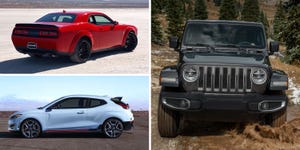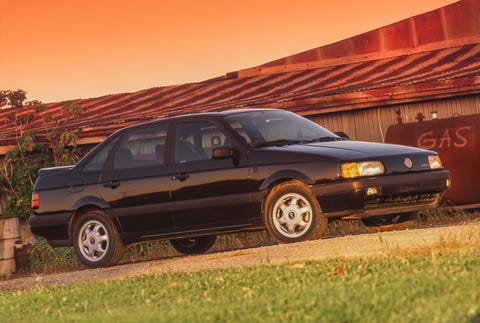From the February 1993 issue of Car and Driver.
The sport of rapid propulsion requires the proper equipment: a good radar detector, knowledge of local gendarmerie methods, and, most important, a stealthy accomplice. Which, if you look around, is no longer easy to find.
The last wave of high-performance sedans—the Taurus SHO, the Infiniti Q45, the Saab 9000 Turbo—kept their rorty powerplants and exceptional handling hidden beneath anonymous styling. Fashions change, and the current speed demons—cars such as the Pontiac SSEi—wear their prowess like a codpiece.
Enter Volkswagen with its revamped Passat sedan tagged the GLX. The $21,520 GLX shares its drone-like profile with the standard Passat but covertly adds a 172-hp version of the company’s new VR6 engine.
The VR6’s 38-hp boost over the base 134-hp four-cylinder transforms the formerly mild-mannered Passat into a deceptively quick ally. Zero-to-60-mph times drop from 9.3 seconds to 7.7 seconds, quick enough to keep close company with the toughest Maximas and Camrys. VW claims a top speed of 130 mph, but our car’s governor pulled in the reins at 121.
For traveling incognito, it’s hard to beat the Passat’s clean, riffless lines, especially in our test car’s Johnny Cash outfit. Even dripping in hellfire red paint, like the long-term GL model we had last year, a Passat runs virtually unnoticed by lawmen looking for scofflaws. The VR6 model can be distinguished from the base car only by a few extra exterior badges, fog lamps, handsome BBS wheels, and a conservative spoiler. Volkswagen also sells the GLX as a wagon, which, as you might guess, looks even more innocuous.
You won’t mistake the interior of the Passat for a Pontiac, either. The dash sits high, and knee bolsters add to its visual mass. The switches vary in shape and texture, but they’re all made from hard black plastic. The appearance is conservative and tasteful but stark. Optional leather trim livens up the dark interior immensely. (Our test car wore grippy black velour peppered with multicolored confetti.)
Like all Passats, the GLX is a feat of packaging. It can carry four full-sized adults and all of their luggage without injury. The driver and front passenger have plenty of room, even though the standard power sunroof takes a moderate bite out of headroom. The huge amount of rear legroom allows VW to equip the back seats with recliners, so passengers can lounge in peace on long hauls. The rear seats also flip down to create a large, flat cargo floor.
Handling remains the Passat’s strongest virtue. The VR6’s additional power makes it easier to push the firmly tuned suspension to its limits. Pressed hard, its secure front-wheel-drive grip gives way to predictable, benign understeer. The steering feel remains a bit controversial—some of us like its heft, others think the artificial loading makes it twitchy on highway slogs—but it snaps off-center and builds force progressively.
The GLX also retains the controlled freeway ride and excellent braking of previous Passats. Although the suspension feels quite firm, it executes deep knee bends over larger ruts, filters away smaller road imperfections, and still circles the skidpad at an impressive 0.82 g—better than a Taurus SHO’s 0.81 g. Four-wheel disc brakes, with great pedal feel and without fade, stop the GLX from 70 mph in 185 feet.
The Passat GLX’s transformation from commuter to Q-ship would have been more dramatic if it had included the needed drivetrain and ergonomic improvements. Although Volkswagen says that 85 percent of the 177 pound-feet of torque is available from 2000 to 6000 rpm, peak torque is reached at a relatively high 4200 rpm. Shift the five-speed manual transmission before redline, and the GLX betrays otherwise sparkling performance.
Fifth gear should be reserved for interstates only. A sluggish 50-to-70-mph time of 11.7 seconds makes top-gear lane changing unwise. (That’s 2.3 seconds slower than the Camry SE and 1.8 seconds slower than a Maxima SE.) Passing or climbing gentle grades usually requires a down shift to fourth gear, sometimes even third. Highway cruising speeds are met with silence: The VR6 emits a hushed burble, and wind noise is kept to a minimum.
Our complaints about the feel of the manual gearbox in previous Passats hold true for the GLX. The clutch engagement is markedly smoother than in other Volkswagen products, but the shift action remains vague. The tubby shift lever doesn’t snick into gear—it flops. We tried VW’s new electronically controlled four-speed automatic in another GLX and found it to be well executed. It cleanly switches gears, downshifts when asked without fuss, and has an economy mode to boot.
Ergonomically, the interior has some glaring flaws. The power-mirror switch doesn’t fall easily to hand, and the power rear-window switches are located on the dash, just beneath the radio. The climate-control system, however, is intuitively easy to operate. All instruments are neatly marked, but the oddly angled steering wheel obscures the upper ranges of the tach and speedometer in most positions. One thoughtful touch: Passenger-assist handles at all four outboard seats, which are handy when showing the carpool the meaning of the term “slideways.”
Volkswagen wrongly gambled that airbags wouldn’t become a sales issue in the Passat’s lifetime. Annoying motorized belts take the place of three-point belts and supplemental restraints. The Passat already meets next year’s federal standards for side-impact protection, but it won’t get airbags until 1994.
The Passat is one of Europe’s biggest sellers, but in this country it’s been lost against the monolithic backdrop of the Taurus, the Maxima, and the Camry. It still wears a civilian uniform, but with the VR6 upgrade, the GLX finally carves out a suitable niche for the Passat—as an undercover partner in crime.
Counterpoints
My friend the Nissan/VW dealer says used VWs sell like hotcakes—faster than used Nissans. Why? They’re cool. European. They look, feel, ride, and drive with lots of character, you don’t see them everywhere, and they depreciate a bit quicker than similar Asian cars. They’re perfect for the young, trendy, alternative-music types in my friend’s suburban market, myself included. However, new-car buyers spending $22K can be a square lot, easily lured to airbags, Japanese reliability, and less controversial styling. Now ask yourself, am I hip enough to drive a Passat? —Frank Markus
I love what the VR6 engine has done for VW’s Corrado, so I anticipated a totally rejuvenated Passat GLX. Although I’ll admit the power is now good enough to help justify the car’s stiff price tag, I feel something was lost in transplantation. The Passat’s extra mass has subtly diluted the VR6’s magic. Although that may not be a problem to most potential owners of this kind of car, I need sparkling dynamics like the Corrado’s to override the annoyance of motorized belts and the absence of airbags. For me, it makes all the difference. —Barry Winfield
The appearance of an out-of-state VW GTI in the C/D lot often means a new road warrior has arrived for his summer dream job. Now young enthusiasts won over by junior German oomph, agility, and aura have a sophisticated and exciting VW sedan to graduate into, because the roomy Passat has a 172-hp V-6. Here’s a coiled spring that will propel them to work on time while they learn to take alarm clocks seriously. And they should look for pinstripes as stylish as this Passat’s upholstery for those first five suits. The downside: Payments on a $21,690 GLX will grow a kid up quick. —Mary Beth Lewis
This content is created and maintained by a third party, and imported onto this page to help users provide their email addresses. You may be able to find more information about this and similar content at piano.io








